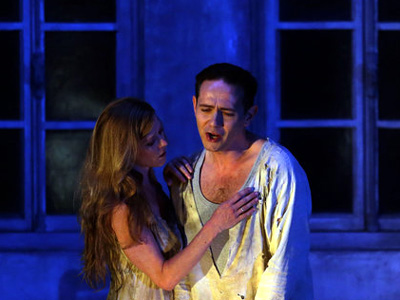By: Frank Cadenhead
The September 15 press conference was unusually packed for the season announcement of Opéra Comique. After being closed for 18 months and under new management, the interest in the future of this iconic Parisian institution was high. The new director, Olivier Mantei, was the only speaker and occupied the stage for about 50 minutes with details of the season and his approach to what will be on the stage at the Comique. Dramatic and innovative are two words to describe his vision.
Mantei describes a season, unusually a calendar year, with eight production, seven of which are new, from February to December of 2017. The only revival in the group will launch the season. From 12 to 27 February, Fantasio of Jacques Offenbach, staged by young director Thomas Jolly, will be hosted by the Théâtre du Châtelet, apparently while finishing touches of the Salle Favart are completed.
“When the Salle Favart burned for the second time, 150 years ago, the Opéra Comique company migrated to the Théâtre du Châtelet,” commented Mantei and that welcome mat was still around. Châtelet is itself closing for many months of interior restoration and their abbreviated season had space. The extra seats at Châtelet will allow Mantei to offer a thousand seats at 25 Euros for the under 25 set and additional thousand for 35 Euros to those under 35.
With the fully restored hall, the season will be 10 months instead of the recent 7 or 8 and the budget will be €20 million, up from 16. How this can be sustained is in the details. There will be 50% more performances in a season, producing a hoped-for increase in ticket sales. The other noticeable thing in the season brochure is the number of co-productions of each offering. Some will see their first performance in other houses but all will circulate. Mantei had the time to plan with other theaters in Europe and that sharing will ease the dizzy cost of presenting opera.
The second production of the season, La Princesse légère, a world premiere of an opera for young people by Violeta Cruz, will allow all to experience the “new” Salle Favart in March. The next month Alcione by Marin Marais is on the schedule with Jordi Savall and the chorus and orchestra of La Concert des Nations. While this composer’s name became famous with the French film Tout les matins de monde, his works are rare on stage.
Six June performances of Le timbre d’argent (The silver stamp), a forgotten opera of Camille Saint-Saëns, are much anticipated. One of his 13 operas, subsequent performances did not go well and it was shelved despite positive notice from Bizet and Massenet. The libretto is by Jules Barbier and Michel Carré who wrote librettos for Faust and Les Contes d’Hoffmann.
At the end of September, a lyric creation, Miranda, features music of Purcell woven into a story of memories and emotions inspired by the death of the title character. After their acclaimed collaboration with Bach cantatas, the expectations are high for Katie Mitchell and the young conductor Raphaël Pichon and his orchestra and chorus, Ensemble Pygmalion. In October, a new opera, Kein Licht, by the French composer Philippe Manoury, will see its French debut. A commission of the Opéra Comique, it will have first performances at the RuhrTriennale in August with subsequent performances in Luxembourg, Zagreb, Strasbourg and Munich. The Magic Flute in November originates from the Komische Oper Berlin with a production directed by Suzanne Andrade and Barrie Kosky (who also serves as intendant there). The season closes in December with Rossini’s Le Comte Ory with Louis Langrée conducting the Orchestre des Champs-Elysées and a new staging by Denis Podalydès.
It is obvious that Olivier Mantei has no interest in spoon-feeding his audience the standard repertory. The season booklet is filled with new initiatives which points to a clear intent to be an incubator for creativity. He has transformed the “Academie” – a collection of resident and associated singers, some at the top of their careers, some at the beginning – into the Troupe Favart, a collection that replicates a group that principally work with one company. The icing on the cake for this new season is that the Opéra Comique will launch a new pastry, the “Favart,” a nod to its chief competition, Opéra.
The Opéra Comique season: http://www.opera-comique.com/en/seasons/2017-season
